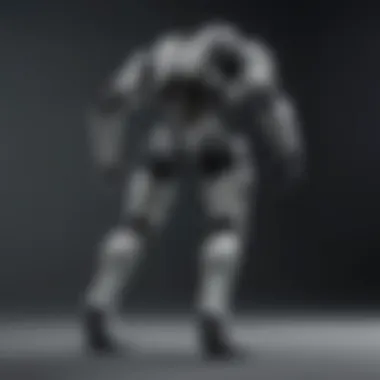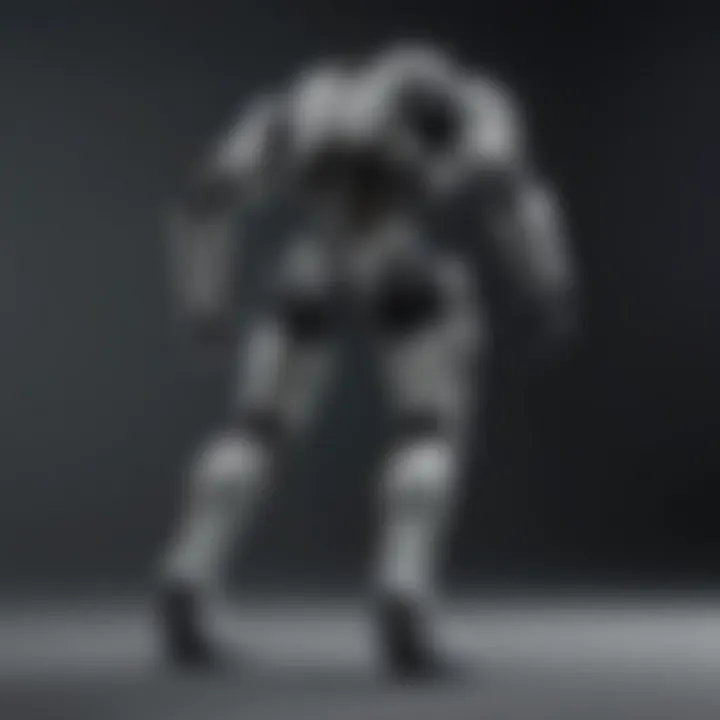Exploring Lower Body Exoskeletons in Mobility Solutions


Article Overview
Purpose of the Article
The main goal of this article is to delve into the role and significance of lower body exoskeletons in modern mobility solutions. By examining their technological advancements, various designs, and applications, we aim to inform an audience of students, researchers, educators, and professionals about how these devices are transforming mobility. Lower body exoskeletons represent a remarkable intersection between technology and human enhancement, offering new pathways to improve mobility for diverse groups.
Relevance to Multiple Disciplines
Lower body exoskeletons touch many fields. They are important in healthcare, rehabilitation, and ergonomics. Additionally, they have implications for aging populations and those with disabilities. Workers in manual labor sectors also benefit from these technologies. Each discipline can provide unique insights into the design and ethical considerations of exoskeletons, enriching the conversation about their potential impact on society.
Research Background
Historical Context
The concept of exoskeletons is not new. Early iterations appeared during the 1960s. The focus was mainly on military and industrial applications. Over the past few decades, significant advancements have lead to a surge in interest. Research now integrates robotics, biomechanics, and artificial intelligence. The goal is to create devices that safely augment human mobility. As a result, these advancements have opened up new possibilities for rehabilitation and assistive technology.
Key Concepts and Definitions
To understand the impact of lower body exoskeletons, it is important to clarify key terms:
- Exoskeleton: A wearable device that supports, enhances, or assists movement. It can be powered or passive.
- Mobility: The ability to move freely and easily, critical for maintaining independence.
- Rehabilitation: A series of therapies aimed at restoring function due to injury or disability.
These definitions establish a foundation for discussing how lower body exoskeletons contribute to enhancing mobility across various demographics.
Prologue to Lower Body Exoskeletons
Lower body exoskeletons represent a significant advancement in mobility technology. These devices are designed to assist individuals in walking and other movements. Their importance cannot be overstated, especially when considering the varied groups they benefit, from the elderly to those engaged in physically demanding jobs. Lower body exoskeletons enhance mobility, improve quality of life, and support independence. This section discusses the critical aspects surrounding the development and use of these innovative devices.
Definition and Overview
A lower body exoskeleton is a wearable robotic device that is worn externally on the legs and lower torso. Its primary purpose is to support movement, primarily walking. These mechanisms work by mimicking the natural motion of the human body. The core components include actuators, which provide the necessary power; sensors that track movement and adjust to the user's needs; and a supportive structure that helps align the device with the human body. Applicable in both medical and industrial contexts, lower body exoskeletons can reduce strain on the user's body and contribute to overall efficiency in movement.
Lower body exoskeletons come in various styles and functionalities. Active exoskeletons use motors and sensors to assist with movement actively, while passive exoskeletons rely on springs for support. The key benefit of these devices is their potential to vastly improve mobility for individuals who may struggle to walk independently.
Historical Context
The concept of exoskeleton technology has roots in both fiction and early industrial applications. Originally, the idea was primarily explored in science fiction, portraying how machines could enhance human capabilities. However, research began to evolve in the late 20th century with a focus on practical applications in medical rehabilitation and industrial settings. Early models were bulky and limited in functionality, making them impractical for everyday use.
Over time, advancements in materials and robotics have led to more versatile and lighter designs. The introduction of advanced materials, like lightweight composites, has also contributed to making exoskeletons more user-friendly. In recent decades, the combination of robotics, sensor technology, and computer processing has allowed for the development of exoskeletons that can adapt to user movements seamlessly. Today, lower body exoskeletons are actively used in rehabilitation therapy, mobility assistance, and even as a means to alleviate worker strain in industries such as construction.
As these devices continue to evolve, they remain at the forefront of discussions about mobility solutions and the ways they can enhance the lives of users. Their ongoing development will likely shape future approaches to mobility support, addressing both functional needs and social implications.
Mechanics of Lower Body Exoskeletons
The mechanics of lower body exoskeletons are crucial to understanding their role in enhancing mobility. By breaking down their components and design, we can see how they contribute to improved movement for different individuals, particularly those with mobility challenges. This section focuses on the specific elements that make these devices effective, including their components and the types of exoskeletons available.
Key Components
Actuators
Actuators are vital parts of lower body exoskeletons. They enable the movement of the exoskeleton by converting energy into mechanical motion. Typically, actuators are designed to move in a way that mimics natural human motion. One key characteristic is their responsiveness, allowing users to easily navigate various terrains.
One unique feature of actuators is their ability to provide assistance according to the user's needs. This makes them suitable for different tasks, from basic walking to more complex movements like climbing stairs. However, a drawback is that some actuators can be bulky, which may limit the user's range of motion in certain situations. Despite this, their functional benefits make them a popular choice for enhancing mobility.
Sensors
Sensors play a critical role in monitoring the user's movements. They capture data on body position, speed, and external conditions. A significant aspect of sensors is their precision, which allows the exoskeleton to adjust in real-time. This capability ensures better synchronization between the user and the device.
The unique feature of sensors lies in their potential for integration with advanced technologies. For example, some sensors utilize machine learning algorithms to improve performance over time. While sensors enhance the overall functionality of the exoskeleton, they may also increase the device's complexity, leading to potential issues with troubleshooting and maintenance.
Structure
The structure of lower body exoskeletons dictates their durability and user comfort. A well-designed structure aims to provide support without hindering natural movement. The lightweight materials used in construction are a key characteristic, enabling ease of use without excessive fatigue.
A notable feature of modern structures is their adaptability. Many exoskeletons are designed to fit different body types, making them accessible to a wider range of users. On the downside, the materials used must withstand wear and tear from regular use. While some structures can be highly durable, maintaining this balance of weight and durability can be challenging for manufacturers.
Types of Exoskeletons


Lower body exoskeletons come in two main types: passive and active. Understanding these types helps grasp how they can be utilized in practical scenarios.
Passive Exoskeletons
Passive exoskeletons leverage mechanical systems such as springs or harnesses to aid movement without external power. They are often lighter and less expensive than their active counterparts. A key characteristic of passive exoskeletons is their simplicity, which makes them easier to maintain.
Their unique feature lies in their ability to redistribute weight and reduce strain on the user's body. This makes them an effective choice for tasks requiring prolonged periods of standing or walking. However, they might fall short of providing the same level of assistance and adaptability as active exoskeletons. Thus, they are more suited for specific applications rather than all-encompassing mobility solutions.
Active Exoskeletons
Active exoskeletons are powered devices that use motors and actuators to assist users in movement. This type offers greater flexibility and support, making them a preferred option for individuals facing severe mobility challenges. The key characteristic of active exoskeletons is their dynamic adaptability, as they adjust assistance based on the user's motion.
Their unique feature is the integration of sophisticated technologies, such as real-time feedback systems. This enhances user experience but can also lead to higher costs and more complex maintenance requirements. Overall, while active exoskeletons provide substantial support for enhancing mobility, their reliance on power sources may limit accessibility in certain contexts.
In summary, understanding the mechanics of lower body exoskeletons is key to appreciating their impact on mobility solutions. Each component and type plays a significant role in determining how individuals can benefit from these technologies.
In summary, understanding the mechanics of lower body exoskeletons is key to appreciating their impact on mobility solutions. Each component and type plays a significant role in determining how individuals can benefit from these technologies.
Applications in Healthcare
Lower body exoskeletons are increasingly recognized for their significant contributions to transforming healthcare practices. The integration of this technology creates a profound impact on both patient outcomes and rehabilitation processes. These devices not only offer physical support but also assist in psychological recovery by fostering a sense of normalcy and independence among users.
Rehabilitation
In the realm of rehabilitation, lower body exoskeletons present pioneering advantages. They facilitate various therapeutic exercises for patients recovering from injuries, strokes, or surgeries affecting mobility. By supporting the user’s body weight, these devices allow individuals to practice walking and other movements that might otherwise be impossible or unsafe. The repetitive nature of these tasks helps rebuild muscle strength, enhance joint mobility, and promote neural recovery.
Moreover, studies have demonstrated that the use of exoskeletons in physical therapy can lead to improved gait patterns and increased overall muscle activity compared to traditional rehabilitation methods. For instance, the Ekso GT exoskeleton is designed specifically for therapeutic settings, enabling therapists to guide patients effectively through their rehabilitation journey.
Another critical aspect is the potential for personalization of therapy. Various models include adjustable settings that can tailor the support level according to each patient's unique needs. This adaptability often leads to higher motivation and engagement during rehabilitation sessions.
Assistance for Mobility Impairments
Lower body exoskeletons provide a new horizon for individuals with mobility impairments, enhancing their daily life significantly. The technology grants users the ability to perform daily activities with greater ease. Many people with conditions such as spinal cord injuries or muscular dystrophy can regain some level of independence, which is crucial for self-esteem and mental health.
Exoskeletons such as the ReWalk system allow users to stand unaided, walk again, and navigate environments that they may have once considered inaccessible. These devices often come equipped with smart features that adapt to different walking terrains, ensuring user safety. In addition, the compact design of many exoskeletons has made them more practical for home use, further increasing their appeal.
The societal implications of this technology cannot be understated. Providing tools that enable individuals with disabilities to integrate more fully into community life enhances their quality of life and reduces the burden on caregivers.
"Lower body exoskeletons are not just assistive devices; they are a gateway to independence for many users."
"Lower body exoskeletons are not just assistive devices; they are a gateway to independence for many users."
Industrial Applications
The integration of lower body exoskeletons into industrial settings represents a significant milestone in enhancing workforce capabilities. These devices play a crucial role in increasing efficiency and safety among workers engaged in physically demanding tasks. The applications can be seen across various sectors including manufacturing, logistics, and construction. As the workforce ages and labor shortages persist, exoskeletons provide a viable solution to maintain productivity and health.
Enhancing Worker Productivity
Lower body exoskeletons are designed to assist workers during repetitive and strenuous activities. By mechanically supporting movement, these devices enable individuals to perform tasks with less fatigue. For instance, in warehouses, workers often lift heavy packages. Utilizing exoskeletons allows them to lift and carry loads that would typically lead to quicker exhaustion.
In addition to reducing fatigue, enhancing worker productivity contributes to overall efficiency. Studies show that workers using exoskeletons can accomplish more over the same period compared to those who do not use these devices. Tasks like squatting and bending are less taxing, allowing employees to maintain higher energy levels throughout their shifts. This leads to faster completion of tasks and can ultimately boost the bottom line for companies.
Reducing Occupational Injuries
One of the most pressing issues in industrial environments is the high rate of occupational injuries. Lower back pain, joint injuries, and musculoskeletal disorders are prevalent among workers engaged in manual labor. Implementing exoskeletons can play a key role in mitigating these risks. By providing support during movements, these devices help maintain proper posture and reduce strain.
According to experts, workplaces that have adopted lower body exoskeletons have reported a reduction in injury-related costs. The devices not only assist during lifting but also when standing for long periods. The advancements in design mean that exoskeletons can adjust to individual body shapes and sizes, providing tailored support. This customization further enhances their effectiveness.
"Integrating lower body exoskeletons into the workplace not only promotes safety but also creates a culture that values employee well-being."
"Integrating lower body exoskeletons into the workplace not only promotes safety but also creates a culture that values employee well-being."
Impact on the Aging Population
The aging population is growing rapidly across the globe. This demographic shift significantly affects healthcare and social systems. One of the pressing issues is mobility. Many older adults face challenges with physical movement due to aging-related ailments. Lower body exoskeletons present a potential solution. Their design focuses on enhancing mobility, thus addressing critical needs in this age group.
Addressing Mobility Issues
Mobility issues can range from weakened muscles to joint pain. Lower body exoskeletons help counteract these challenges. They provide support and stability, allowing users to stand up, walk, and navigate environments with more ease. These devices often include features that align with the user’s natural movements. This adaptability makes them more beneficial for older adults, who may otherwise struggle with traditional walking aids.


- Increased Support: Exoskeletons distribute weight evenly, reducing strain on joints.
- Improved Gait: Many models offer assistance that corrects gait patterns, promoting safer walking.
- Physical Rehabilitation: These devices can help in rehabilitation settings, encouraging movement through technology.
In this way, lower body exoskeletons can address both preventive and reactive aspects of mobility decline in seniors.
Promoting Independence
Independence is a crucial aspect of quality of life. For older adults, losing the ability to move freely can lead to feelings of isolation and dependence on caregivers. Lower body exoskeletons can promote independence effectively. When individuals can manage their mobility, their overall confidence increases.
"Maintaining independence is vital for the psychological well-being of older adults. Exoskeletons can help achieve this goal."
"Maintaining independence is vital for the psychological well-being of older adults. Exoskeletons can help achieve this goal."
- Self-sufficiency: With enhanced mobility, older adults can engage in daily activities without help.
- Social Engagement: Improved movement allows for better interaction with peers and community.
- Enhanced Quality of Life: When seniors regain movement, they can enjoy life more fully.
Such benefits highlight the transformative potential of lower body exoskeletons in modern society. By focusing on mobility, these technologies not only assist in day-to-day operations but also empower users emotionally and psychologically.
Challenges in Development
The development of lower body exoskeletons faces various challenges that can impact their effectiveness and acceptance. Addressing these challenges is crucial to ensure that these devices serve their intended purpose, offering enhanced mobility and independence to users. Understanding technical limitations and user acceptance are particularly important for advancing this technology.
Technical Limitations
Technical limitations primarily relate to the engineering and mechanical aspects of exoskeleton design. Some common issues include:
- Battery Life: Many exoskeletons rely on batteries for power, which can limit their operational time. The longer users need to wear the device, the more critical battery efficiency becomes.
- Weight: An ideal exoskeleton should be lightweight and easy to wear for extended periods. However, integrating powerful actuators and durable materials often leads to increased weight, which can hinder mobility.
- Control Systems: The sophistication of control systems is vital for seamless user interaction. Current systems may not always accurately interpret user intentions, leading to erratic movements, which can be both frustrating and potentially hazardous.
- Adaptability: Lower body exoskeletons should adapt to various user needs and environments. The lack of standardization in body types and sizes complicates the customization process.
Overcoming these issues requires ongoing research and considerable investment from manufacturers. Solutions involve developing materials with higher strength-to-weight ratios and creating advanced algorithms for more responsive control.
User Acceptance
User acceptance can significantly affect the success of lower body exoskeletons. Several factors influence this acceptance:
- Comfort and Fit: If an exoskeleton does not fit comfortably, users are less likely to adopt it. Comfort can be subjective, requiring manufacturers to focus on personalized design.
- Ease of Use: A steep learning curve can deter potential users. Exoskeletons must be intuitive to operate, requiring minimal training. If users find it complicated, they may reject the device.
- Social Attitudes: People’s perceptions about using assistive technology can influence acceptance. Stigma associated with mobility devices may discourage individuals from using exoskeletons, despite their potential benefits.
- Cost: Economic factors play a significant role in user acceptance. The high cost of developing and purchasing exoskeletons might limit access for many potential users.
Addressing user acceptance is essential for the widespread adoption of lower body exoskeletons, as successful integration into daily life is often contingent on user perception and experience.
Addressing user acceptance is essential for the widespread adoption of lower body exoskeletons, as successful integration into daily life is often contingent on user perception and experience.
Ethical Considerations
The advancement of lower body exoskeletons presents important ethical considerations that warrant thorough examination. As these technologies continue to evolve and integrate into everyday life, the implications of their use must be considered carefully. This section covers two main ethical dimensions: equity in access and privacy concerns. Understanding these aspects helps shed light on how exoskeletons can become inclusive tools, rather than sending society down a path of inequity.
Equity in Access
Equity in access refers to the fair distribution of lower body exoskeletons among all demographic groups. As technology progresses, it is vital to ensure these devices do not become a luxury reserved for a few. Accessibility should be a priority. Historically, advanced medical technologies often benefit wealthier individuals or regions, leaving poorer populations behind. Issues such as income disparity and geographic location can drastically affect who has access to these life-enhancing systems.
Potential solutions to these access disparities could involve government policies or public health initiatives. Here are some ways to foster more equitable access:
- Government Funding: Increased funding for research and subsidies for low-income patients could help democratize exoskeleton technologies.
- Collaboration with NGOs: Non-governmental organizations could play a role in distributing these devices to underprivileged areas.
- Insurance Coverage: Expanding healthcare coverage to include exoskeletons ensures that individuals with mobility challenges can access the necessary support.
Greater equity in access not only improves individual lives but also upholds the values of justice and fairness within society. By prioritizing inclusion, we encourage a future where technology serves the collective well-being.
Privacy Concerns
The deployment of lower body exoskeletons raises significant privacy concerns. These devices often utilize data collection tools such as sensors and cameras to enhance user experience. However, this creates risks regarding how personal data is handled. It is critical to ensure that users maintain control over their own information.
Some of the associated risks include:
- Unauthorized Data Access: Sensitive information could be exposed to unauthorized entities, leading to potential misuse.
- User Surveillance: There is a danger of surveillance if location data or usage statistics are collected and used without consent.
Solutions to address these issues could include:
- Data Encryption: Securing user data through encryption helps safeguard personal information.
- User Consent Policies: Clear guidelines for data collection and sharing should be established, ensuring informed consent from users.
- Transparency in Data Usage: Companies should disclose how user information will be used and stored.
Privacy is a fundamental right; safeguarding it in the context of advanced technologies like exoskeletons enables trust between users and developers.
Privacy is a fundamental right; safeguarding it in the context of advanced technologies like exoskeletons enables trust between users and developers.


By addressing both equity in access and privacy concerns, we can maximize the positive impact of lower body exoskeletons while minimizing ethical pitfalls. These considerations are essential for creating an environment where technology fosters inclusion and respects individual rights.
Regulatory Framework
The regulatory framework surrounding lower body exoskeletons is crucial for their effective integration into both healthcare and industrial sectors. As the technology advances, it is necessary to establish specific guidelines and regulations to ensure safety, efficacy, and equitable access. The importance of regulation lies in balancing innovation and consumer protection. This framework provides a structured environment for manufacturers and developers, guiding them in compliance, product testing, and market approval processes.
Current Regulations
Current regulations involve multiple aspects, such as safety standards, performance criteria, and user guidelines. In the United States, the Food and Drug Administration (FDA) classifies exoskeletons as medical devices and mandates rigorous testing for usability and safety prior to market entry.
Some key regulations include:
- Risk Assessment: Each product must undergo a comprehensive risk assessment to identify potential hazards associated with its use.
- Testing Protocols: Developers are required to follow strict protocols to evaluate the functionality and durability of exoskeletons.
- Labeling Requirements: Clear labeling is essential for guiding users through proper usage and maintenance of the device.
In Europe, the Medical Device Regulation (MDR) similarly oversees exoskeletons, ensuring they conform to established safety and performance benchmarks. These regulations not only protect the end-users but also foster trust between users and manufacturers, which is essential in a competitive market.
Future Policy Directions
Looking ahead, future policy directions must evolve in response to technology development and user feedback. The regulatory landscape should adapt to the rapid pace of innovation while prioritizing user safety and accessibility. Some anticipated policy directions include:
- Streamlined Approval Processes: Simplifying approval protocols for proven technologies can accelerate access to valuable solutions for users in need.
- International Standards Development: Collaborating globally can establish internationally recognized standards for lower body exoskeletons, facilitating easier market entry across borders.
- User-Centric Regulations: Policies should consider insights from actual users and healthcare providers, leading to user-friendly designs and effective applications.
Ultimately, as the application of lower body exoskeletons expands, a well-rounded regulatory framework is essential to promote ethical development and wide-scale acceptance. Comprehensive regulations can ease public concerns and bolster confidence in the efficacy of these remarkable technologies.
"The future of lower body exoskeletons relies on robust regulatory frameworks that ensure safety while embracing innovation."
"The future of lower body exoskeletons relies on robust regulatory frameworks that ensure safety while embracing innovation."
Engagement with stakeholders, including users, regulators, and manufacturers, will be valuable for shaping effective policy directions that truly reflect the needs of society.
Future Directions in Research
Research in lower body exoskeletons continues to evolve. Future directions in this field hold significant implications for mobility solutions. Innovations can lead to better performance, user comfort and wider acceptance. Researchers and developers are working on various aspects that could enhance the impact of exoskeletons. By focusing on improvements, they can address current limitations and unlock greater potential for users.
Innovations in Materials and Design
Material innovation is critical for the next generation of lower body exoskeletons. Lightweight, durable materials like carbon fiber and advanced polymers can improve wearability. They allow for greater mobility without sacrificing strength. Additionally, manufacturers are exploring smart textiles that adapt to user movements.
Design concepts are also evolving. The goal is to create more user-friendly and aesthetically pleasing exoskeletons. Attention to ergonomics enhances user comfort, while customization options cater to individual needs.
For example, integrating flexible joints can allow for natural movement, reducing fatigue. Furthermore, advancements in 3D printing technology enable rapid prototyping of customized designs. This technology reduces production costs and time, leading to quicker commercialization.
Potential for Integration with AI
Artificial Intelligence (AI) integration presents another exciting direction. Smart algorithms can analyze user movements in real time, adjusting support levels dynamically. This offers tailored assistance based on individual capabilities.
Predictive analytics could enhance safety. For instance, AI could anticipate potential falls or instability, allowing the exoskeleton to respond proactively. Machine learning models will also support ongoing performance assessments, helping to refine the user's experience.
"Integrating AI into lower body exoskeletons has the potential to revolutionize personal mobility by creating systems that adapt in real time to user needs, ensuring both efficiency and safety."
"Integrating AI into lower body exoskeletons has the potential to revolutionize personal mobility by creating systems that adapt in real time to user needs, ensuring both efficiency and safety."
Ultimately, the convergence of advanced materials, innovative designs, and AI technology marks a new era for lower body exoskeletons. It addresses functional limitations while enhancing the user experience. This synergy will likely shape the future landscape of mobility solutions, making them more accessible and beneficial for diverse populations.
Closure
Lower body exoskeletons represent a significant advancement in mobility solutions today. Their role transcends mere technological curiosity, as they provide profound benefits to various groups. In summary, these devices can enhance movement for those who find walking or standing challenging. Specifically, they serve individuals with disabilities, support the aging population, and improve productivity for laborers.
Summary of Findings
This article sheds light on several key elements regarding lower body exoskeletons. First, they can reduce the physical strain on users, thereby decreasing the risk of injuries. Second, the devices can be integrated into rehabilitation programs, promoting recovery in patients. Third, the evolving technology holds promise for AI integration, which can further personalize the user experience.
Moreover, the exploration of eco-friendly materials in their design can contribute to sustainability in the industry.
"The adoption of lower body exoskeletons is not an isolated technological change; it is part of a broader movement towards enhancing quality of life and productivity across different sectors."
"The adoption of lower body exoskeletons is not an isolated technological change; it is part of a broader movement towards enhancing quality of life and productivity across different sectors."
Implications for Society
The implications for society are multifaceted. First, lower body exoskeletons have the potential to foster independence among individuals facing mobility challenges. By enabling better mobility, they can enhance participation in social and economic activities.
Additionally, the use of these devices can decrease healthcare costs associated with mobility-related issues. In industrial sectors, they can improve worker efficiency and satisfaction, leading to better overall output.
However, the societal acceptance of this technology must be approached with caution. Considerations surrounding accessibility, affordability, and regulatory issues remain crucial to ensure equitable distribution of these innovations.



